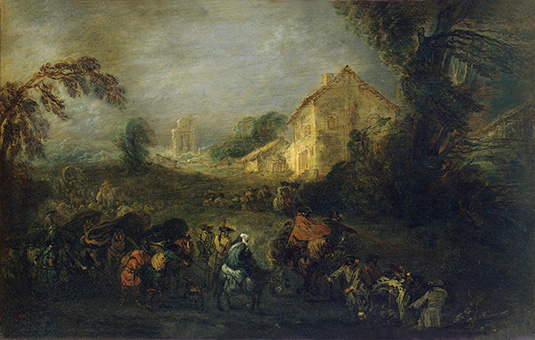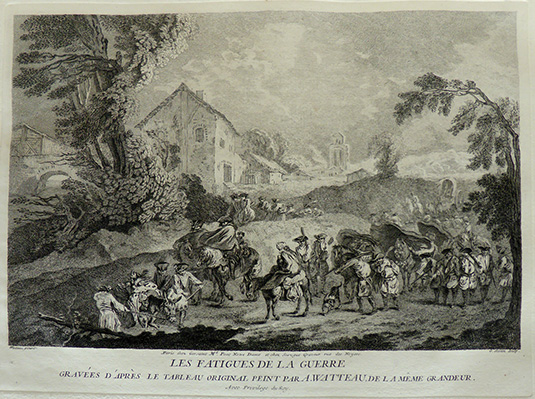
- Home Page
- Accepted
Paintings & Copies - Doubtful
Attributions - Doubtful Textual References
- Alternative
Titles - Collectors &
Museums - Bibliography
- Search Abecedario
- Watteau &
His Circle
Les Fatigues de la guerre
Entered May 2022; revised June 2022

St. Petersburg, Hermitage Museum, inv. ГЭ-1159
Oil on copper
21.5 x 33.5 cm
ALTERNATIVE TITLES
The Burdens of War
Le fatiche della guerra
Les Fatigues de guerre
Hardships of War
Marche de troupes
Die Mühsalen des Krieges
Soldaten auf dem Marsche
RELATED PRINTS

Jean-Baptiste Scotin after Watteau, Les Fatigues de guerre, engraving, c. 1731.
Les Fatigues de la guerre was engraved in reverse in 1731 by Jean-Baptiste Scotin. The pendant picture, Les Délassements de la guerre, was engraved at the same time by Louis Crepy fils, and both were announced for sale in the June 1731 issue of the Mercure de France (p. 1564).
PROVENANCE
Paris, collection of Antoine de La Roque (1672-1744; military officer, newspaper publisher). His sale, Paris, April 1745, lot 44: “Deux des plus piquans Tableaux que Vatteau ait peint; ils sont sur cuivre, ils portent douze pouces & demi de large sur douze pouces de haut; ils représentent des Sujets de Guerre; je les ai fait graver sous les Inscriptions des Fatigues & des Délassemens de la Guerre, par M. Crepi. Ils sont très-purs, extrêmement finis, & en même-tems touchez avec tout l’esprit & toute la finesse dont Vatteau étoit capable.” Sold for 680 livres to Edme Gersaint for the account of the marquis de Calviere (according to the Getty Research Institute).
Paris, collection of Louis Antoine Crozat, baron de Thiers (1700-1770). The painting was cited in situ in Dezallier d’Argenville, Voyage pittoresque de Paris, 3rd ed.(Paris: 1757), 137: “Une Marche de Troupes & une Halte; deux petits ouvrages de Watteau . . . .” Also, cited there by Hébert, Dictionnaire pittoresque (1766), 161. Cited by La Curne de Sainte-Palaye, Catalogue Crozat (1755), 57. Crozat’s collection was sold en bloc to agents of Catherine the Great of Russia in 1777.
St. Petersburg, collection of Catherine II (1729-1796; Empress of Russia).
EXHIBITIONS
Moscow, Pushkin Museum, French Art of the 15th-20th Centuries (1955), 24.
Leningrad, L’Art français des XIIe-XXe siècles (1956), cat. 12.
Leningrad, Hermitage, Watteau and His Time (1972), cat. 6 (as by Watteau, Military Respite [in Russian}, lent by the Hermitage).
Dresden, Meisterwerke aus der Ermitage, Leningrad, und aus dem Pushkin Museum, Moscow (1972), cat. 49.
Schleissheim, Alt and Neue Schloss, Kurfürst Max Emmanuel (1976), cat. 395.
Washington, Paris, Berlin, Watteau 1684-1721 (1984), cat. 15 (as by Watteau, The Burdens of War [“Les fatigues de guerre”], lent by the Hermitage).
SELECT BIBLIOGRAPHY
Mariette, “Notes manuscrites,” 9: fol. 192, no. 24.
La Curne de Sainte-Palaye, Catalogue Crozat (1755).
St. Petersburg, Hermitage, Catalogue (1774), cat. 976.
Dézallier d’Argenville, Voyage pittoresque (1757), 137.
Hébert, Dictionnaire pittoresque (1766), I: 101.
St. Petersburg, Hermitage, Livret (1838), cat. 32.
Viardot, Les Musées d'Allemagne et de Russie (1844), 457.
Hédouin, “Watteau” (1845), cat. 55.
Hédouin, Mosaïque (1854), cat. 56.
Goncourt, L’Art au XVIIIème siècle (1860), 30, 53, 56.
Lejeune, Guide théorique et pratique (1864), I: 213, 215.
Cousin, Le Tombeau de Watteau (1865), 25.
Duplessis, Les Merveilles de la gravure (1869), 349.
Goncourt, Catalogue raisonné (1875), cat. 54.
Dussieux, Artistes français à l’étranger (1876), 580.
Clément de Ris, “Le Musée imperial de l’Ermitage” (1880), 269.
Goncourt, L’Art du XVIIIe siècle (1880), 30, 53, 56.
Mollett, Watteau (1883), 62.
Mantz, Watteau (1892), 59-60.
Phillips, Watteau (1895), 27.
Tourneux, “Diderot et le musée de l’Ermitage” (1898), 340
Dilke, French Painters (1899), 78-79.
Phillips, “The Picture Gallery of the Hermitage” (1901), 605-6.
Phillips, “The Wallace Collection” (1901), 260.
Staley, Watteau (1902), 143.
Josz, Watteau (1903), 130.
Somov, Catalogue de la galerie des tableaux (1903), 108.
Watteau, Masters in Art (1903), 41.
Séailles. “Antoine Watteau peintre militaire (1906), 239.
Pilon, Watteau et son école (1912), 22, 77, 78.
Zimmermann, Watteau (1912), 176, no. 30.
Gillet, Un Grand maître (1921), 46, 52.
Dacier, Vuaflart, and Hérold, Jean de Jullienne et les graveurs (1921-29), 1: 122, 178, 263; 2: 35, 83, 133, 161, 162; 3: 87, cat. 138, under cat. 179, cat. 216.
Séailles, Watteau (1927), 62, 123.
Réau, “Watteau” (1928), cat. 42.
Ingersoll-Smouse, Pater (1928), 13.
Brinckmann, Watteau (1943), 54.
Adhémar, Watteau (1950), cat. 96.
Sterling, Great French Paintings (1958), 40-41.
Mathey, Watteau, peintures réapparues (1959), 67.
Cailleux, “Four Studies of Soldiers” (1959), v, vii.
Nemilova, Watteau et ses oeuvres à l’Ermitage (1964), 42-54, 157, 183-185.
Martin-Méry, Chefs-d’oeuvre de la peinture française (1965) cat. 45.
Macchia and Montagni, L’opera completa di Watteau (1968), cat. 97.
Stuffmann, “Collection Crozat” (1968), cat. 185.
Hilles, “Sir Joshua’s Selection of Paintings,” (1969), 209.
Ferré, Watteau (1972), cat. A 6.
Cailleux, “Watteau and His Times' at the Hermitage,” (1972), 734.
Zolotov, Watteau (1973), cat. 3.
Nemilova, “Contemporary French Art in Eighteenth-Century Russia” (1975), 436.
Roland Michel, Watteau (1981), cat. 137.
Roland Michel, Watteau (1984), 96-97, 113, 167-69, 265, 269, 298.
Posner, Watteau (1984), 38-40.
Washington, Paris, Berlin, Watteau 1684-1721 (1984), under cat. 15.
Nemilova, French Painting of the XVIII Century (1985), cat. 33.
Zolotov et al., Watteau (1985), cat. 9.
Nemilova, French Painting Eighteenth Century (1986), 452.
Temperini, Watteau (2002), cat. 33.
Glorieux, Watteau (2011), 96.
Wile, Watteau’s Soldiers (2016), 40, 42, cat. 48.
RELATED DRAWINGS
Unlike most of Watteau’s other military subjects, no known drawings from the model are associated with this painting.
REMARKS
As with almost all of Watteau’s military subjects, the dating of Les Fatigues de la guerre used to center on Watteau’s return to Valenciennes. Previously this was thought to have occurred in 1709, but Hattori’s discovery of his application for a passport to travel to Valenciennes places his trip in November or December of 1710. That said, a compendium of the dates proposed for these paintings, including Les Fatigues de la guerre, reveals that there is little agreement as to when Watteau painted it. The proposed dates range from 1711 to 1716—which is a considerable span of years in relation to the brevity of Watteau’s career. Moreover, there is no correlation between the date proposed and when the opinion was rendered. Glorieux, one of the most recent scholars, suggested 1711; Mathey preferred 1712 just as Cailleux suggested a date no later than 1712; Rosenberg preferred 1712-13; Wile decided on 1713-14; Macchia and Montagni assigned the painting to 1714; Adhémar listed the work for 1712-15 but seems to have favored a date close to 1715; Roland Michel first declared for 1714-15 but a few years later wrote that the painting could not have been executed later than 1712-13; Grasselli and Temperini favored 1714; Sterling and Posner claimed 1714-15; Zolotov and Nemilova opted for 1715; and finally Martin-Méry selected 1715-16, which is the latest date proposed.
Les Fatigues de la guerre and its pendant, Les Délassements de la guerre, were planned as opposites, as recognized in the titles they were given when engraved. They represents contrasting aspects of military life. Les Fatigues emphasizes the struggle to handle large cumbersome bundles and the buffeting effects of strong wind and inclement weather. On the other hand, Les Délassements features canteen tents and relaxing soldiers, lolling on the grass or playing cards, all set against a verdant, sunlit landscape. The opposition of themes—registered in the men’s activities and in the effects of the weather—was an idea explored by Poussin and Gaspard Dughet, and extended through the eighteenth century to the brilliantly theatrical creations of Carle Vernet.
Click here for copies of Les Fatigues de la guerre